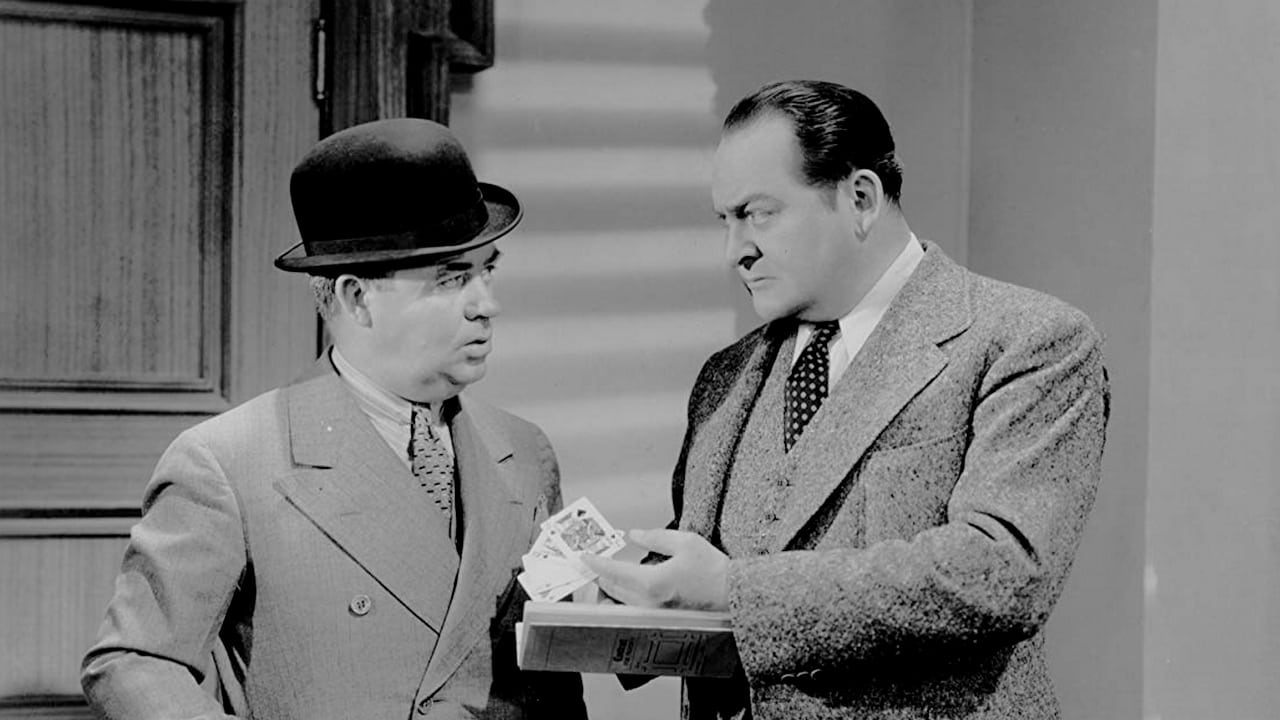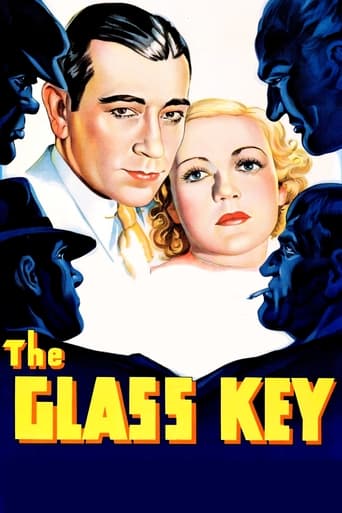

Don't Believe the Hype
... View MoreAmateur movie with Big budget
... View MoreTells a fascinating and unsettling true story, and does so well, without pretending to have all the answers.
... View MoreGreat story, amazing characters, superb action, enthralling cinematography. Yes, this is something I am glad I spent money on.
... View MoreWith "The Glass Key" George Raft bounced back in popularity after some of the worst reviews in his career ("The Trumpet Blows", "Limehouse Blues") and I agree with the other reviewers, it is a pretty good movie. It was supposed to be Dashiell Hammett's favourite of the books he had written. The nominal female lead was the delectable Claire Dodd. She could play any role - as long as it was high class - no "dese, dems and dose" for her. She could be the archest "cat" or the perfect secretary when she played Della Street to Warren William's Perry Mason. Unfortunately here she is not playing opposite George Raft, what sparks they could have made. She was in her snooty society girl mode and played Janet Henry, daughter of "above reproach" Senator Henry. She has also turned the head of genial Paul Madvig (Edward Arnold) who is sick of always being called upon to get shady characters out of scrapes - he wants to clean up the town and his act.His right hand man Ed Beaumont (Raft) is also concerned about Madvig's daughter Opal (insipid Rosalind Culli) who is a bit too friendly with Janet's ne'er do well and obviously cad of a brother Taylor (Ray Milland). When Taylor is found murdered "someone" implicates Madvig, who was known to have disliked him and Ed has an uphill battle trying to convince Paul that he is not the "Mr. Popularity" around town that he thinks he is. He even goads Paul into a fight to find out who that "someone" is. It wouldn't be a George Raft movie without some pretty realistic fight scenes including one with an attack dog and another where Ed gets out of a sticky situation by kicking his protagonist in the shins!!! Roughed up by a vicious thug (Guinn "Big Boy" Williams in the role of his career) who is no match for Ed in the "smarts" department. After another playful going over, Ed has to start a fire in the hideout and then crash through a roof to the safety of a family who promply call an ambulance.The "someone" is finally found - he is Schloss, brother in law of a driver involved in a nasty car accident who had gone to Paul for help only to be turned away. You do get a feeling who the murderer is but it is all wrapped up very nicely. Unfortunately Raft's leading lady was not vivid Claire Dodd but boring Rosalind Culli. Culli? Keith? Culli-Keith?? What was her name?? In fact the only reason she is now remembered is for the confusion with her name. As Rosalind Culli she was announced to appear in "The Glass Key", during the filming her name was changed to Culli-Keith but when the movie opened, hey presto she was Rosalind Keith!!!
... View MoreCrime novelist Dashiell Hammett is best-known for penning THE THIN MAN and THE MALTESE FALCON and, like the latter's original 1931 film version was completely overshadowed by John Huston's classic 1941 remake, the same fate practically befell another of his filmed works. In fact, the original 1935 version of THE GLASS KEY has been all but impossible to see until recently, while its 1942 remake was easily available on DVD in Europe. Although I do own a copy of the latter, it has been ages since I watched it last and cannot sensibly compare the two versions now; having said that, the credits for the original – director Frank Tuttle (who would later make a star out of Alan Ladd in THIS GUN FOR HIRE and whose next picture, ironically enough, was the aforementioned remake of THE GLASS KEY!), stars George Raft (this obviously made him the first choice for Sam Spade in the remake of FALCON, but he turned it down to Bogie's eternal benefit!), Ray Milland and Ann Sheridan, plus character actors Edward Arnold, Guinn Williams and Irving Bacon – are sufficiently interesting to merit its re-evaluation as a worthy precursor to the noir subgenre.Raft is influential lawyer Arnold's right-hand man who, carrying on from his own star-making turn in Howard Hawks' SCARFACE (1932), has an eye for his boss' sister; when the former decides to become the ally of the local political candidate (because he too has his heart set on the latter's sister!), everything starts to go wrong for him, especially after turning down the defense of a drunken motorist from a manslaughter charge and when setting his foot down on the nightclub owned by the local underworld kingpin. However, it is the politician's inveterate gambler son Milland who proves to be the catalyst for disaster as, ostensibly pursuing the affections of Arnold's daughter, he is truly after milking the girl out of her funds to satiate the aforementioned criminal with whom he is indebted. This state of affairs naturally pits Arnold and Milland at loggerheads and it is up to the quick-witted Raft to shuffle his boss out of a murder rap when Milland's corpse is found lying in the gutter one night after the latest scuffle with his prospective father-in-law! At one point in the narrative – in a brutal sequence anticipating the later ones featuring Dick Powell's Philip Marlowe and Ralph Meeker's Mike Hammer in, respectively, Edward Dmytryk's MURDER, MY SWEET (1944) and Robert Aldrich's KISS ME DEADLY (1955) – Raft suffers greatly at the hands of the criminal's chief henchman Williams (effectively cast against type) and, eventually, ends up in hospital where he is nursed by a pre-stardom Sheridan. Yet, despite having also been assaulted by a massive dog, he goes back for more and, ultimately, defeats the thug by turning him against his own employer. The identity of the real murderer is not all that mysterious in itself but the journey to the denouement is an exciting ride and, indeed, it is kickstarted by a spectacular car-crash right in the very opening scene! For what it is worth, the characters of Arnold's mother and card-trick obsessed odd-job man, providing here the requisite elements of sentimentality and comic relief, were dispensed with for the remake in those somber days of WWII.
... View MoreThis is before noir. There aren't any noir elements in it. But there is something else: the type of tough guy that would become a staple. It seems to have started with Hammett. We already had the loyal man, strong and true and sometimes coming back from a beating. But this guy's a rascal, womanizer and gambler. A tough guy dedicated to someone who by ordinary standards isn't worth it. George Raft is as good in this as Bogart ever was later after the type had been established. The story is pretty interesting too if you make allowances for the bizarre coincidences, the circular personal connections and the trite resolution. What's interesting is the twist. By itself, it is ordinary, but Hammett seems to have known that the twist also has to reinforce the types because the whole thing is about the types.This surely is not the first time a hoodlum is portrayed sympathetically. But it is the first time I know that it is done well and integrated with the structure of the story. There's a particular scene worth noting. Our hero was nearly beaten to death by a big thug. He escapes. This really was brutal.Later, he goes to a bar where he knows this guy is. The thug is drunk. They to an upstairs room by themselves to have some more drinks before the thug plans to finish off Raft. We know this thug has just violently killed a simple man. Raft is supremely cool and of course comes out more than okay. If this were noir, he wouldn't; he wouldn't be in control. But this is an anti-noir where a human can be in control. He is.Ted's Evaluation -- 2 of 3: Has some interesting elements.
... View MoreThis early adaptation of Hammett's novel is not as well known as the Alan Ladd version but is very much worth seeing. Different in some ways, eerily similar in some ways, it's usually a little more raw than the later remake (the car crash that opens the film is still jarring today). And as the other reviewer notes, it has all the classic noir elements. Definitely worth seeking out.
... View More